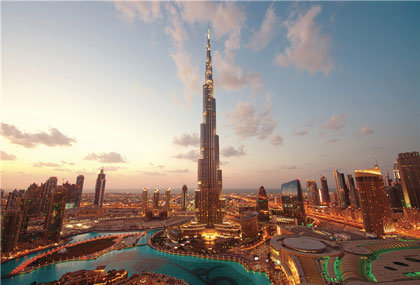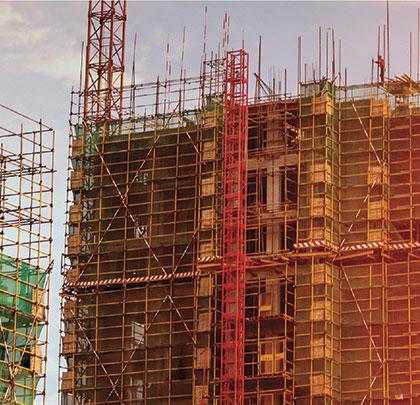The world’s tallest skyscrapers that are transforming city skylines from Shanghai to Dubai are impressive for their architecture and engineering, but perhaps their most important design element lies in the safety of these modern marvels. Chief among these safety features is fire protection. There are myriad codes and regulations relating to fire safety in commercial buildings, from standards on portable fire extinguishers to the installation of stationary pumps for fire protection—the U.S. based National Fire Protection Agency (NFPA) alone has more than 300 consensus codes that have been adopted in whole or in part in countries throughout the world.
As rapid urbanization around the globe continues to spur construction of high-rise residential and commercial structures, hospitals, schools and other buildings—an expected 2.4 billion more people will live in urban areas by 2050 with over 90 percent of them in Africa and Asia—applying the strictest safety measures for fire protection is paramount to safeguarding life and property.
Development in these emerging markets creates both opportunities and challenges for fire service. Since there is not one widely implemented fire code that governs international new construction and building remodeling—and enforcement of existing codes varies widely by country and local jurisdiction—reducing costs often trumps improving safety.
The 2015 New Year’s Eve fire in Dubai in which flames raced up the exterior of the sixty-three-story hotel and a 2013 fire at a nightclub in Brazil that killed more than 240 people are shocking and tragic reminders of what can happen when there are gaps in safety regulations and enforcement. The United Arab Emirates had previously updated its Fire and Life Safety Code of Practice to ban the use of the highly combustible exterior cladding blamed for the fire, but buildings erected prior to 2012 still are vulnerable. In Brazil, there were no sprinklers in the building, though they were required by code.
These tragic events underscore the need to move toward greater uniformity in codes and standards to ensure consistent application—from the initial design phase to final construction—in order to eliminate ambiguity and establish the highest level of fire protection in all corners of the world.
LIVING CODES
Code development is generally done by Standards Developing Organizations (SDOs) in the United States, or internationally by ISDOs. These model codes serve as the basis for most building regulations, which may be amended or overridden by local bylaws or government agencies. In Europe, the prevailing standard is adapted by fire protection oversight organizations and then further altered on a country-by-country basis. In emerging markets such as the UAE and China, government leaders have adopted some of the existing codes and standards from developed markets, including the United States and Europe, to advance fire protection.
Closer examination of the standards that apply to pumps for fire protection shows the differences that exist among the predominant standards and underscores the importance of proper design and installation of fire pumps. These standards should be considered in the context of whole system performance and redundancy in fire safety systems to reduce the risk of death, injury, and property damage.

It’s important to note that these various codes and standards on fire protection are not equal, interchangeable, or enforceable by SDOs/ISDOs. Adoption of safety standards often is decided on a local level by officials who weigh cost of compliance with acceptable levels of risk. This is a complicated and subjective formula—a balance among political, economic, business competition, and other factors, and the value placed on safety and what is willing to be sacrificed for that safety.
KEY ROLES
Other organizations, such as listing authorities like Underwriters Laboratories (UL), which governs electrical standards, and Factory Mutual Research Corporation (FM), a global insurer, influence building design and code development. These testing and certification organizations develop their own standards as well—UL Standards cover fire pump controllers, fire pump motors, and fire pump relief valves, and are important third-party certifications for manufacturers to obtain.
Both UL and FM representatives sit on technical committees that review and develop standards, such as the NFPA Technical Committee on Fire Pumps. Further, in areas where local codes are weak or not enforced, listing authorities are sometimes regulators by default in cases in which their standards are more stringent.
When the Standard for Installation of Stationary Pumps for Fire Protection known as NFPA 20, added multistage, multiport pumps as part of its 2016 update, it prompted FM to add multistage pumps to its FM 1311 standard for centrifugal fire pumps, improving safety in areas where FM regulations are the predominant standard.
Manufacturers of fire protection equipment also play an important role in shaping technical regulations on fire protection. They can affect codes and standards in advisory roles as noted above and also through the development of new products. Products with improved technologies, for example, can affect the operating procedures within fire protection systems or, if technology outpaces system capabilities, expose system vulnerabilities. For instance, NFPA’s Technical Committee on Fire Pumps is considering the need for a common means to remotely access fire pump controller data; currently, each manufacturer has a proprietary means.
Also, as construction practices evolve, codes become obsolete and refinements must be made to these living codes. In order to keep pace with these inevitable changes, American standards that fall under the auspices of the American National Standards Institute (ANSI) must be reviewed at least every five years—NFPA updates codes every three years. CEN, the European Committee for Standardization, conducts a systematic five-year review of its standards. The European insurance federation known as CEA, updates its requirements every two to three years. During the interim periods, technical bulletins are issued as warranted.
PUMP STANDARDS
Without question, the fire pump is one of the most critical pieces of equipment inside a building. The pump takes water from an external water supply, such as a public utility or reservoir, and provides the required water flow and pressure for the fire protection system.
Reliable, code-compliant fire protection systems begin with the consulting engineer or designer, tasked with meeting the overall project objectives and selecting the necessary systems for the project. He or she must be knowledgeable in each component of the system and understand how each component will affect the selection of another component, and how they will all work together. The development of codified performance-based approaches to system design has begun to present designers with the necessary tools to better anticipate the building’s performance in the event of a fire and a clear assessment of risks in terms of the overall project objectives.
Standards governing fire pumps are most often included in broader guidelines for automatic sprinkler systems as the fire pump is a crucial part of the overall system. Some standards are loose guidelines for further code development; others that are more detailed and complex are designed to account for all conceivable scenarios in order to ensure maximum protection.
A LOOK AHEAD
As our world continues to grow in complexity, codes, and standards that help shape our built environment will continue to evolve in order to protect health and safety for all. The codes of tomorrow will likely include things not even being contemplated today. In next month’s conclusion, we will provide a summary of the leading standards and how they are applied. ◆
Brian Buscher is a global marketing manager for Xylem’s A-C Fire brand with expertise in centrifugal pump systems for fire suppression in industrial and commercial facilities. He is a principal member of the NFPA 20 Technical Committee on Fire Pumps. Buscher holds a bachelor’s degree from Northeastern Illinois University. Any comments/opinions made are the author’s own and not those of NFPA. For more information, visit www.xylem.com.
____________________________________________
MODERN PUMPING TODAY, April 2017
Did you enjoy this article?
Subscribe to the FREE Digital Edition of Modern Pumping Today Magazine!
![]()


